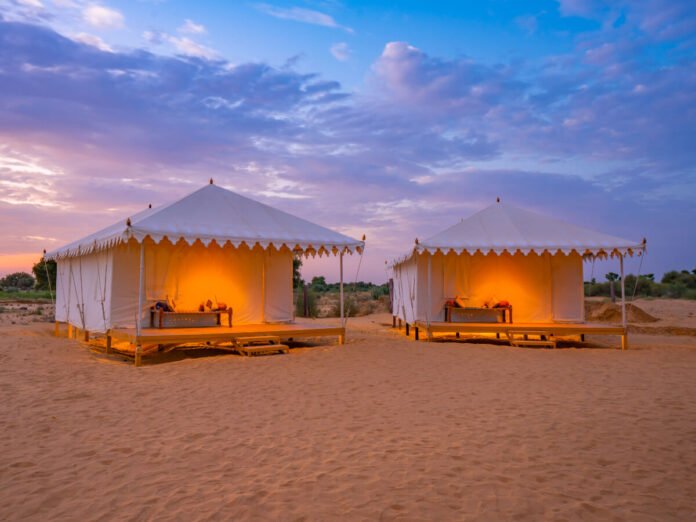Jaisalmer, known for its golden sands and historic fortresses, is also home to a hidden gem that offers a unique blend of natural beauty and wildlife wonders: Desert National Park. This vast expanse of arid landscape provides a sanctuary for a diverse array of flora and fauna, making it a must-visit for nature enthusiasts and adventure seekers alike. In this article, we delve into the enigma of Desert National Park, uncovering its unique attractions and why it’s a wildlife haven in the heart of the Thar Desert.
The Unique Ecosystem of Desert National Park
Desert National Park, sprawling over an area of 3,162 square kilometers, is one of the largest national parks in India. Despite the harsh conditions, it hosts a remarkable variety of life. The park’s terrain is a mix of craggy rocks, compact salt lake bottoms, intermedial areas, and fixed dunes, creating a unique ecosystem that supports diverse wildlife.
Flora: A Resilient Greenery
The flora of Desert National Park is adapted to survive in extreme conditions. The vegetation mainly comprises thorny bushes, cacti, and xerophytic plants, which are well-suited to the arid environment. Trees such as the Khejri, Rohida, and Ronj not only provide a splash of greenery but also serve as crucial resources for the park’s wildlife.
Fauna: A Sanctuary for Rare Species
The park is renowned for its population of the Great Indian Bustard, a critically endangered species. Desert National Park is one of the last strongholds for this magnificent bird, which can often be seen in its natural habitat here. Besides the bustard, the park is home to several other bird species, including eagles, harriers, falcons, buzzards, and kestrels. Birdwatchers can also spot the sandgrouse, partridges, bee-eaters, larks, and shrikes.
Mammals in the park include the Indian fox, desert fox, wolf, and the Bengal fox. Reptiles such as the spiny-tailed lizard and monitor lizard are also common sights. The park’s diverse fauna and the unique desert landscape make it an unparalleled destination for wildlife enthusiasts.
Experiencing Desert National Park
To fully experience the wonders of Desert National Park, visitors can embark on a safari, which offers a close-up view of the park’s wildlife and stunning landscapes. The best time to visit is between October and March when the weather is pleasant and the chances of spotting wildlife are higher.
Safari Adventures
Desert safaris in the park are typically conducted in 4×4 vehicles, which are ideal for navigating the challenging terrain. Knowledgeable guides accompany visitors, providing insights into the park’s ecosystem and the behaviors of its inhabitants. These safaris often cover the most scenic and wildlife-rich areas of the park, offering a thrilling and educational experience.
Birdwatching Excursions
For avid birdwatchers, Desert National Park is a paradise. Special birdwatching tours are organized, focusing on the park’s avian residents. These tours are best conducted early in the morning or late in the afternoon when birds are most active. The sight of the Great Indian Bustard in its natural habitat is a highlight of these excursions.
Staying Near Desert National Park
Visitors to Desert National Park can enhance their experience by staying at nearby accommodations that offer comfort and a taste of local culture. One such place is the Desert Camp in Jaisalmer, which provides an authentic desert experience with a touch of luxury.
Rajwada Desert Camp: A Luxurious Retreat
Located close to the park, Rajwada Desert Camp offers a blend of traditional Rajasthani hospitality and modern amenities. Guests can stay in well-appointed Luxury Tents in Jaisalmer, which provide comfort and a unique experience of the desert environment. The tents are equipped with all necessary facilities, ensuring a pleasant stay amidst the rugged beauty of the Thar Desert.
Conservation Efforts and Challenges
Desert National Park faces several challenges, primarily due to the fragile nature of its ecosystem. Conservation efforts are crucial to protect its unique biodiversity. The park authorities, along with various wildlife organizations, are actively involved in preserving the habitat of the Great Indian Bustard and other species.
Community Involvement
Local communities play a vital role in the conservation efforts. By promoting eco-tourism and involving locals in park activities, the park authorities aim to create a sustainable model that benefits both wildlife and the people living in the surrounding areas. Education and awareness programs are conducted to highlight the importance of conserving this unique ecosystem.
Conclusion
Desert National Park is a testament to the resilience and beauty of nature in the face of harsh conditions. Its unique ecosystem, diverse wildlife, and stunning landscapes make it a must-visit destination for anyone traveling to Jaisalmer. Whether you’re a wildlife enthusiast, a birdwatcher, or simply seeking an adventure in the desert, Desert National Park offers an unforgettable experience. So, pack your bags and get ready to explore the enigma of this wildlife haven in the heart of the Thar Desert.


